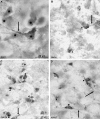Early GABA(A) receptor clustering during the development of the rostral nucleus of the solitary tract
- PMID: 12739616
- PMCID: PMC1571086
- DOI: 10.1046/j.1469-7580.2003.00169.x
Early GABA(A) receptor clustering during the development of the rostral nucleus of the solitary tract
Abstract
While there is an abundance of gamma-aminobutyric acid (GABA) in the gustatory zone of the nucleus of the solitary tract of the perinatal rat, we know that GABAergic synapse formation is not complete until well after birth. Our recent results have shown that GABA(B) receptors are present at birth in the cells of the nucleus; however, they do not redistribute and cluster at synaptic sites until after PND10. The present study examined the time course of appearance and redistribution of GABA(A) receptors in the nucleus. GABA(A) receptors were also present at birth. However, in comparison to GABA(B) receptors, GABA(A) receptors underwent an earlier translocation to synaptic sites. Extrasynaptic label, for example, of GABA(A) receptors was non-existent compared to GABA(B) receptors at PND10 and well-defined clusters of GABA(A) receptors could be seen as early as PND1. We propose that while GABA(A), receptors may play an early neurotransmitter role at the synapse, GABA(B) receptors may play a non-transmitter neurotrophic role.
Figures



References
-
- Belhage B, Hansen GH, Elster L, Schousboe A. Effects of GABA on synaptogenesis and synaptic function. Perspectives Dev. Neurobiol. 1998;5:235–246. - PubMed
-
- Bradley RM, King MS, Wang L, Shu X. Neurotransmitter and neuromodulator activity in the gustatory zone of the nucleus tractus solitarius. Chem. Senses. 1996;21:377–385. - PubMed
-
- Brandon NJ, Bedford FK, Connolly CN, Couve A, Kittler JT, Hanley JG, et al. Synaptic targeting and regulation of GABA (A) receptors. Biochem. Soc. Transactions. 1999;27:527–530. - PubMed
-
- Brown M, Renehan WE, Schweitzer L. Changes in GABA-immunoreactivity during development of the rostral subdivision of the nucleus of the solitary tract (rNST) Neuroscience. 2000;100:849–859. - PubMed
Publication types
MeSH terms
Substances
Grants and funding
LinkOut - more resources
Full Text Sources

